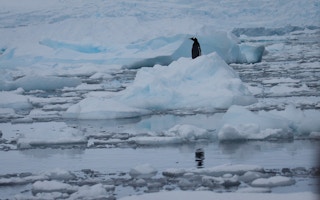It would also lead to polar oceans that are “ice-free” in summer and suffering “essentially permanent corrosive ocean acidification”, the report says.
The 2023 “state of the cryosphere” report from the International Cryosphere Climate Initiative (ICCI) lays out the impacts on Earth’s frozen land and seas from sustained warming at 2°C and the “catastrophic global damage” that would result.
These impacts would include “potentially rapid, irreversible sea level rise from the Earth’s ice sheets”, the report says, with a “compelling number of new studies” all pointing to thresholds of sustained ice loss for both Greenland and parts of Antarctica at well-below 2°C.
This would commit the world to “between 12 and 20 metres” of sea level rise “if 2°C becomes the new constant”.
Holding global warming of 2°C would also not be enough to “prevent extensive permafrost thaw”, the authors say, bringing additional warming from the resulting CO2 and methane emissions. A 2°C world would also see “widespread negative impacts on key fisheries and species” in polar and near-polar oceans.
First published in 2021, the focus of this year’s annual review on how 2°C of warming is “too high” shows that the aspirational limit of 1.5°C in the Paris Agreement “is not merely preferable to 2°C”, but “the only option”, the report says.
The ICCI’s Dr James Kirkham, chief science advisor at the Ambition on Melting Ice high-level group, tells Carbon Brief that the conclusion that 2°C is too high for the cryosphere “won’t come as a surprise at all” to most scientists.
With COP28 in Dubai coming later this month, Kirkham says it is time to make “crystal clear” that “2°C must now be seen as an unacceptable outcome for the world because of the impacts from the cryosphere”.
In this Q&A, Carbon Brief unpacks the report’s findings for the world’s ice sheets, mountain glaciers, permafrost, sea ice and polar oceans.
How can ‘very low’ emissions slow impacts on the cryosphere?
Past emissions of CO2 and other greenhouse gases (GHGs) have “pushed the planet into a risk zone”, the report warns, with very visible impacts on the cryosphere:
“Today’s 1.2°C above pre-industrial already has caused massive drops in Arctic and Antarctic sea ice; loss of glacier ice in all regions across the planet; accelerating loss from both the Greenland and Antarctic ice sheets; extensive permafrost thaw; and rising polar ocean acidification.”
The implications of these changes stretch beyond the Earth’s poles and mountain regions, the authors note, from accelerating sea level rise and disturbed ocean currents to declining water resources and greater carbon emissions.
Nearly all of these changes “cannot be reversed on human timescales”, the authors warn, and they will continue to grow with each additional 10th of a degree of temperature rise.
Kirkham likens the way the cryosphere responds to warming to a “bowling ball once thrown”. He tells Carbon Brief:
“The changes will continue to roll on long after its initial climatic push because the system has momentum.
“[This means] that many of the long-term challenges associated with the cryosphere are on the cusp of being locked in by decisions made by policymakers in the next few years, and the awareness in the policy world of this ‘lock in’ appears lost right now.”
While the aim of restricting global warming to “well-below” 2°C is set out in the Paris Agreement, the report says the “physical reality” of the cryosphere’s response to warming means these changes “would become devastating” well before 2°C is reached.
However, warming of 2°C is not a “predetermined outcome”, the authors say, arguing that “only a strong, emergency scale course-correction towards 1.5°C…can avert higher temperatures, to slow and eventually halt these cryosphere impacts within adaptable levels”.
A “very low” future emissions pathway that would keep warming within, or very close to, 1.5°C – the more stringent part of the Paris goal – remains “physically, technologically and economically feasible”, the report says.
This is the “SSP1-1.9” pathway from the set of Shared Socioeconomic Pathways (SSPs) used in the sixth assessment report (AR6) of the Intergovernmental Panel on Climate Change (IPCC).
Under this pathway (see table below), fossil fuel emissions decline 40% by 2030 and global warming peaks at 1.6C before declining to around 1.4°C by the end of the century.

IPCC AR6 emissions pathways. Credit: ICCI (2023)
Under very low emissions, the Earth’s cryosphere would “generally [begin] to stabilise in 2040-80”, the report says:
“Slow CO2 and methane emissions from permafrost continue for one-two centuries, then cease. Snowpack stabilises, though at lower levels than today. Steep glacier loss continues for several decades, but slows by 2100; some glaciers still will be lost, but others begin to show regrowth. Arctic sea ice stabilises slightly above complete summer loss. Year-round corrosive waters for shelled life are limited to scattered polar and near-polar regions for several thousand years.”
In addition, while “ice sheet loss and sea level rise will continue for several hundred to thousands of years due to ocean warming”, the authors say, it will “likely not exceed three metres globally and occur over centuries”.
All other emissions pathways, including “low” emissions where warming peaks at 1.8°C, would “result in far greater committed global loss and damage from [the] cryosphere, continuing over several centuries”, the report warns.
Is the ‘true guardrail’ for preventing dangerous sea level rise actually 1°C?
The Earth’s ice sheets on Greenland and Antarctica together hold enough ice to raise global sea levels by 65 metres. The risks of significant amounts of this ice being lost irreversibly on human timescales “increase as temperature and rates of warming rise”, the authors say.
When the ice sheets are in equilibrium, melting ice and the breaking off of icebergs are balanced by mass gain through snowfall. However, “observations now confirm that this equilibrium has been lost” on Greenland, West Antarctica, the Antarctic Peninsula and potentially for portions of East Antarctica, the report says.
This is illustrated in the maps below, which show the gain (blue) and loss (red) in ice on Greenland (left) and Antarctica (right) between 2003 and 2019.
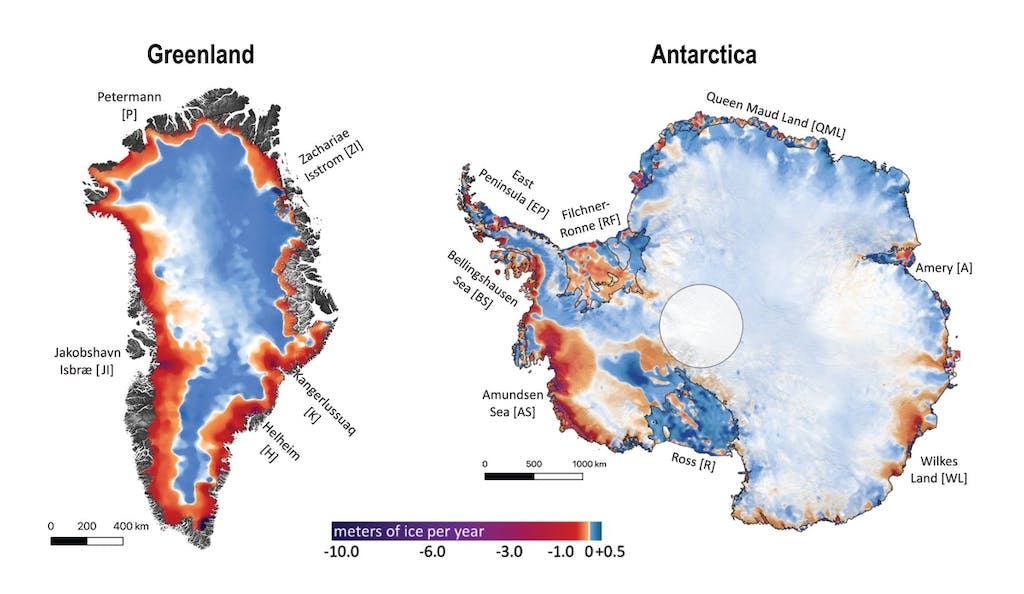
Mass change for Greenland (left) and Antarctica (right) over 2003-19 in metres of ice equivalent per year. The shading indicates gain (blue) and loss (red/purple) of ice. Source: International Cryosphere Climate Initiative (2023) / Smith et al. (2020)
Today, the loss of ice from Greenland is “three times what it was 20 years ago”, the report notes, while Antarctica’s contribution to sea level rise is “six times greater than it was 30 years ago”.
The report paints a bleak picture for the future of both ice sheets. It notes that a “compelling number of new studies” all point to thresholds where irreversible melt becomes inevitable for both Greenland and parts of Antarctica at well below 2°C of warming.
This means that were 2°C of warming to become “the new constant Earth temperature”, the planet would be committed to between 12 and 20 metres of sea level rise.
For example, evidence from proxy data suggests that, in Earth’s distant past, such thresholds have occurred at around 1°C for West Antarctica and the Antarctic Peninsula and between 1.5°C and 2°C for Greenland, the report says. (These contain enough ice to raise sea levels by around five and seven metres, respectively.) It adds:
“It should be noted that changes around past thresholds were driven by slow increases in atmospheric greenhouse gases, but were paced by slow changes in Earth’s orbit – unlike today’s rapid, human-caused rates of change.”
As a result, “many ice sheet scientists now believe that by 2°C, nearly all of Greenland, much of West Antarctica, and even vulnerable portions of East Antarctica will be triggered to very long-term, inexorable sea level rise”.
This occurs because a warmer ocean “will hold heat longer than the atmosphere”, in addition to “a number of self-reinforcing feedback mechanisms, so that it takes much longer for ice sheets to regrow (tens of thousands of years) than to lose their ice”.
This means that “once ice sheet melt accelerates due to higher temperatures, it cannot be stopped or reversed for many thousands of years” – even if temperatures stabilise or even decrease should the world reduce carbon emissions to net-zero, the authors warn.
Lowering sea level rise from newly reached highs would thus “not occur until temperatures go well below pre-industrial, initiating a slow ice sheet regrowth”, the report says:
“Overshooting the Paris Agreement [goal] would therefore cause essentially permanent loss and damage to the Earth’s ice sheets, with widespread impacts that are not reversible on human timescales.”
The report includes the chart below from a 2023 study, which highlights the long-term consequences of global warming. It shows projected global temperature change (top) and the implications for sea level rise (bottom) out to 2150 under four different SSPs.
Under “intermediate” emissions (SSP2-4.5, pink line), which most closely matches the path that the world is on today, sea levels continue to rise. Only “very low” emissions (SSP1-1.9, blue line) would slow and stabilise sea level rise, the report says, “preserving many coastal communities and giving others time to adapt”.
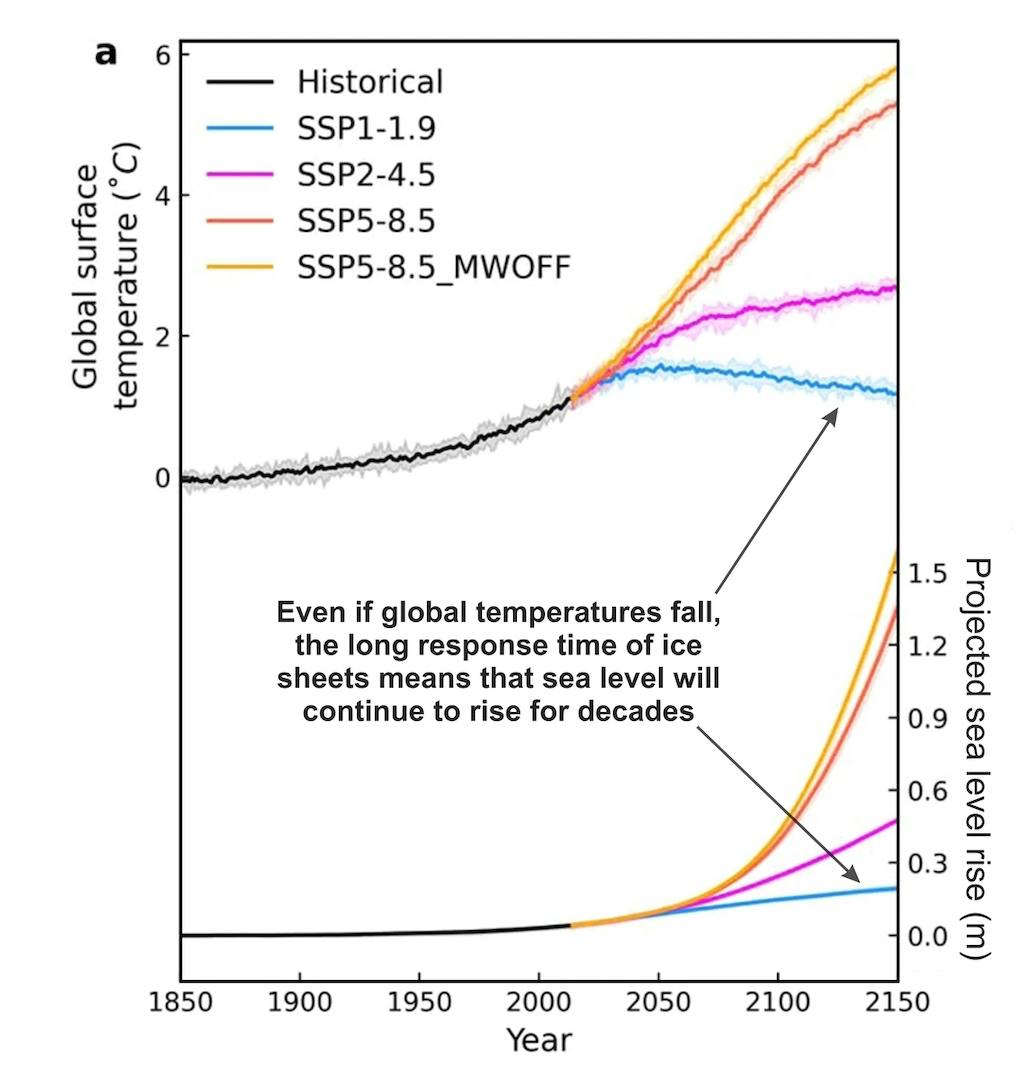
Projected annual changes (relative to the 1850-1900) in global surface temperatures (top) and global sea levels (bottom) from 2014 to 2150. Different colours represent the historical (black line; period 1850-2014) and SSP1-1.9 (blue), SSP2-4.5 (pink), SSP5-8.5 (red) and SSP5-8.5_MWOFF (orange) simulations. (The “MWOFF” indicates simulations where freshwater coupling from the Antarctic meltwater is decoupled.) Solid lines indicate the ensemble mean and shading the ensemble range. Source: International Cryosphere Climate Initiative (2023) / Park et al. (2023)
In the face of this evidence, “for a growing number of ice sheet experts”, the true “guardrail” to prevent dangerous levels and rates of sea level rise is “not 2°C or even 1.5°C, but 1°C above pre-industrial”, the report concludes.
Staying as close as possible to the 1.5°C limit will “allow us to return more quickly to the 1°C level”, the authors say, “drastically slowing global impacts from ice sheet loss and especially West Antarctic ice sheet collapse”.
This would “reduce the risk of locking in significant amounts of long-term, irreversible sea level rise”, the report says. It would also “provide low-lying nations and communities more time to adapt through sustainable development, although some level of managed retreat from coastlines in the long-term is tragically inevitable”.
For world leaders, not committing to reducing emissions in line with the 1.5°C limit is “de facto making a decision to erase many coastlines, displacing hundreds of millions of people – perhaps much sooner than we think”, the authors warn.
Is today’s climate already too warm to preserve some mountain glaciers?
Nearly all glaciers in the north Andes, east Africa and Indonesia – along with most mid-latitude glaciers outside the Himalaya and polar regions – could disappear if the 2°C warming threshold is breached, the report warns.
Many of these glaciers are “disappearing too rapidly to be saved” even in the present climate and could be gone by 2050, while those large enough to survive the century have “already passed a point of no return”, according to the report’s latest projections.
The figure below shows projections of how much ice glaciers in tropical regions would retain, on average, over the next few centuries under different warming levels in 2100. The lines show the impact of warming by 10ths of a degree between 1.4°C and 3C.
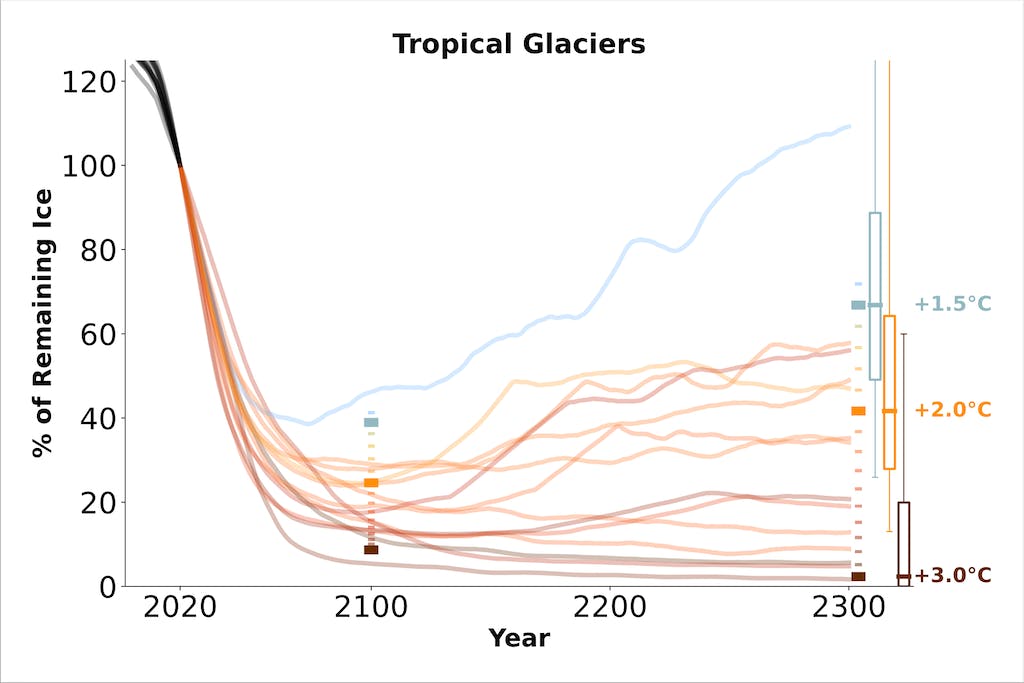
Projections for the percentage of remaining ice in tropical glaciers out to the year 2300 under warming (at 2100) increasing in 10ths of a degree from 1.4°C to 3C. Source: International Cryosphere Climate Initiative (2023) / Schuster et al (2023)
At 2°C, even the Himalayas are slated to lose around half of today’s ice on average, the report estimates. In a very high emissions scenario, 70-80% of the current glacier volume in the Hindu Kush Himalaya could disappear by 2100, the report says, while low emissions would limit glacier loss to 30%.
Without human-induced warming, glaciers in the northern Andes could have served as a reliable source of water for “hundreds of thousands” of years, the report states. Their loss stands to particularly impact villages in northern Peru, Chile and Bolivia and major cities such as La Paz.
This threat to water security is “one of the greatest challenges posed by a melting cryosphere in a 2°C world”, Dr Kirkham tells Carbon Brief, “especially in Asia where freshwater sourced from snow and ice provides a lifeline to over 2 billion people”. He adds:
“This loss of water will even impact some downstream countries that do not contain any snow and ice at all, such as Bangladesh, especially in years when the timing of the monsoon is unreliable.”
Mid-latitude glaciers in the Alps, the Rockies, the southern Andes, Patagonia, Scandinavia and New Zealand are also seeing severe losses.
The report quotes new findings in 2023 showing that the Swiss Alps lost 10% of its glacial ice in just two years over 2022-23, attributed especially to heatwaves, while the Andes witnessed “what may have been the most extreme heatwave on the planet in 2023” in winter.
Warmer temperatures at higher altitudes mean what should be snow is now falling as hazardous extreme rainfall, while other mountain areas face “snow droughts”.
The report finds that most glacier-covered regions outside the Himalaya and the poles have already passed a period of “peak water”, a point at which water availability will only decline each season.
Recovering lost glaciers could take hundreds to thousands of years and temperatures well below the records being set today, the authors note.
However, a low emissions scenario could limit glacier loss in the Himalaya to 30%, with steeper emission cuts stabilising high mountain Asia’s snowpack and glaciers. Some glaciers could eventually even begin to return, the report says.
Rapid cuts consistent with 1.5°C of warming could preserve twice as much ice in Central Asia and the southern Andes, the report estimates.
This could benefit vulnerable communities that depend most on glacial water runoff for drinking water and subsistence agriculture while buying them time to adapt to dangerous climate impacts. For instance, one study cited by the report estimates that 15 million people across the world and especially in high mountain Asia and Peru are at risk of glacial lake outburst floods (GLOFs).
A very low emissions pathway could have benefits for cities and economies beyond agriculture, the report notes. The megacities of Delhi, Los Angeles, Marrakech and Kathmandu are all dependent on meltwater, to a degree, while new research shows growing climate-driven threats to hydropower projects in high mountain Asia due to retreating glaciers, thawing permafrost, GLOFs, avalanches and landslides.
Dealing with the changing water supply from glaciers and snow “may render many of these investments defunct before some of the projects are completed”, warns Kirkham.
Countries including Japan, the US and Switzerland also stand to lose significant revenues from snow-based tourism, while also being exposed to increased risk of wildfires and mudslides linked to the lack of snow cover.
The figure below contrasts the state of Switzerland’s Great Aletsch glacier today – the largest glacier in the Alps – with projections under current emissions and very low emissions scenarios in 2060 and 2100.

Retreat of the Great Aletsch Glacier in Switzerland by mid-century and the end of the century under current and very low emissions scenarios. Credit: International Cryosphere Climate Initiative (2023) / Matthias Huss
However, if warming were limited to 1.5°C, the annual snowpack could stabilise – even if at a lower average amount than today. It adds:
“This visible snow and ice preservation, and its benefits for freshwater resources, may be one of the earliest and visible signs to humanity that steps towards low emissions have meaningful results.”
Dr Miriam Jackson, senior cryosphere specialist at the International Centre for Integrated Mountain Development (ICIMOD) and author on the mountain glaciers chapter of the report, tells Carbon Brief:
“This latest cryosphere report shows, more clearly than ever, that we have a choice. We can continue as we are now and see 80% of glacier loss by the end of this century. Or we can follow a very low emissions pathway, where glaciers and snow cover in high mountain Asia stabilise and eventually begin to return. Millions of people’s livelihoods depend on us making the second choice.”
What impact could permafrost emissions have on the carbon budget?
A global temperature rise of 2°C – “and even 1.5°C” – is too high to prevent the widespread thawing of an icy layer spread across more than one-fifth of the northern hemisphere’s land, the report says.
Permafrost is a mixture of soil, rock and other materials on or under the Earth’s surface that has been frozen for at least two years. It stores a huge amount of ancient, organic carbon.
Research shows that permafrost areas are rapidly warming and, as a result, thawing. This process releases some of the stored carbon into the atmosphere as CO2 and methane, further fuelling global warming. This is known as a “positive feedback”.
“These emissions are irreversibly set in motion”, the report says, and will not slow for one-to-two centuries even if permafrost re-freezes at a later point.
This means that permafrost emissions can further diminish the remaining global “carbon budget” – the amount of CO2 that can still be released while keeping warming below global limits of 1.5 or 2°C.
The report says that carbon budget calculations “must take these indirect human-caused emissions from permafrost thaw into account…not just through [to] 2100, but well into the future”. It adds:
“Permafrost emissions today and in the future are on the same scale as large industrial countries, but can be minimised if the planet remains at lower temperatures.”
The chart below shows the impact of permafrost emissions (pink shaded areas) on the remaining carbon budget (red bars) to stay within 1.5°C and 2°C of warming. Taking permafrost emissions into account significantly reduces the budget estimates, the report says.
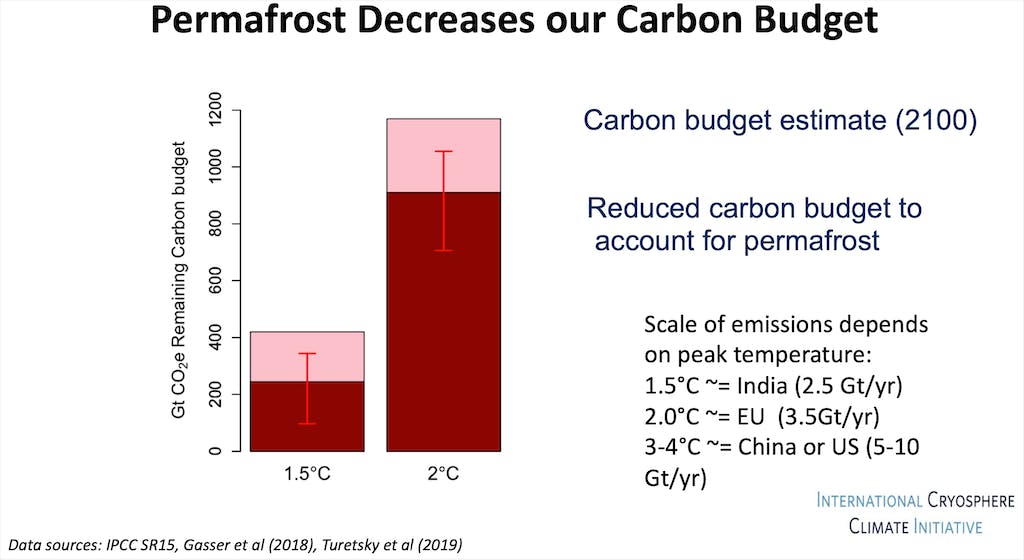
The bars represent the estimated carbon budget at 1.5°C (left) and 2°C (right) of global warming. Within each bar, the pink area shows the estimated permafrost thaw emissions and the red area shows the remaining carbon budget estimate accounting for the permafrost emissions in GtCO2e. Source: International Cryosphere Climate Initiative (2023) / Based on data from IPCC (2018), Gasser et al (2018) and Turetsky et al (2019).
Prof Julie Brigham-Grette, the geosciences graduate programme director at the University of Massachusetts Amherst and author on the report, says she is “very concerned” about permafrost thaw. She tells Carbon Brief:
“The bottom line is that we must reduce fossil fuel use urgently to slow down the demise of glaciers, ice sheets, permafrost, snow cover, sea ice…The climate crisis is real and it’s a threat-multiplier to social and political systems around the world.”
Currently, at 1.2°C of warming, the annual emissions from permafrost are about the same as Japan – the sixth largest emitting country, based on 2019 figures, the report says.
Keeping temperatures below 1.4°C would prevent “most additional new thaw”, the report says. But even at 1.5°C, scientists predict a 40% loss of near-surface permafrost areas by 2100.
At a 2°C global temperature rise, permafrost thawing and associated emissions would continue to climb.
At temperatures of 3C or higher by the end of this century, “much of the Arctic, and nearly all mountain” permafrost would reach the “thawed state”, where it would produce the equivalent of the combined annual GHG emissions of the US and the EU in 2019, for centuries, the report says.
As much as half of recent permafrost thaw occurred during extreme temperature events that were up to 12°C above average, the authors say.
But the report notes that current global climate models do not include these “abrupt thaw” processes in their predictions. Scientists are “still working on these phenomena and what it means for emission rates”, Brigham-Grette says.
Studies analysed in the report found that, overall, permafrost thaw will have a number of “cascading impacts” with “severe” effects already being felt in the Arctic. The report adds:
“Thawing permafrost is causing the loss of Arctic lands, threatening cultural and subsistence resources, and damaging infrastructure, like roads, pipelines and houses, as the ground sinks unevenly beneath them.”
The “only means available” to reduce the problem is to “keep as much permafrost as possible in its current frozen state” and limiting global warming to 1.5°C, according to the report.
What are the prospects for sea ice at the Earth’s poles?
Sea ice at the Earth’s poles undergoes an annual cycle of melting and regrowth. In the Arctic, sea ice melts during the warmer summer months towards its September minimum, before regrowing in the colder winter months. However, as the planet warms, sea ice extent at the September minimum is declining.
The area of Arctic sea ice that “survives” the summer has declined by at least 40% since 1979, the report says. Furthermore, it says, the Arctic ocean has “become dominated by a thinner, faster moving covering of seasonal ice, which typically doesn’t survive the summer”, as opposed to thick, multiyear sea ice.
The authors add:
“Ninety percent of Arctic sea ice loss can be directly attributed to anthropogenic emissions. A threshold has now been crossed in which ice-free conditions in the month of September will occur at times even with very low emissions, and with much slower and later surface freeze-up.”
There is widespread public and scientific interest in when the Arctic might see its first “ice-free” summer. The report highlights a recent study that suggests Arctic sea ice is more sensitive to GHG emissions than was described in the IPCC AR6 report.
The figure below shows projections of September Arctic sea ice area for different emissions scenarios. The different coloured lines indicate different models and the horizontal red line shows the threshold for a “practically ice-free” Arctic, which is one million square kilometres of ice. The lowest emission scenario is shown on the left and the highest emission scenario on the right.

Arctic sea ice projections under four SSPs out to 2100 using different models. The red line indicates a “practically ice-free” Arctic. Source: International Cryosphere Climate Initiative (2023) / Kim et al (2023)
The graphic shows that only the SSP1-1.9 scenario results in “sea ice recovery above ice-free conditions”. At 2°C warming, the Arctic Ocean will be sea ice-free in summer “almost every year”, the report says.
The report concludes that the occurrence of the first ice-free Arctic summer is “unpredictable”, but “inevitable”, adding that it is likely to occur at least once before 2050 even under a “very low” emissions scenario.
Dr Zachary Labe is a postdoctoral research associate at the NOAA Geophysical Fluid Dynamics Laboratory and the Atmospheric and Oceanic Sciences Program at Princeton University, and was not involved in writing the report.
He praises the report, but adds:
“There are countless studies that have evaluated future Arctic sea ice trajectories using models and emergent constraint-like methods, so I advise caution in overly relying on mostly one new study.”
At the Earth’s other pole, Antarctic sea ice saw record-breaking melt in 2023 setting a summer minimum in February 2023. “The unprecedented reduction in Antarctic sea ice extent since 2016 represents a regime shift to a new state of inevitable decline caused by ocean warming,” the authors say.
According to the report, sea ice projections around Antarctica are “considerably less certain” than those in the Arctic. However, the authors say the record-low conditions in 2023 “indicate that its threshold for complete summer sea ice loss might be even lower than for the Arctic”.
The authors also highlight recent research that found thousands of emperor penguin chicks died because of the early breakup of Antarctic sea ice in 2022.
“Perhaps more so than for any other part of the cryosphere, 2°C is far too high to prevent extensive sea ice loss at both poles, with severe feedbacks to global weather and climate,” the authors conclude.
What do rising temperatures and CO2 mean for the polar oceans?
The world’s oceans absorb around one-quarter of all human-produced CO2, which reacts with seawater to produce a weak acid in a process called ocean acidification.
Rates of ocean acidification are currently faster than they have been at any point in the past 300m years, the report finds. Polar waters in the Arctic and Southern oceans have absorbed up to 60% of the carbon taken up by the world’s oceans so far, because colder and fresher waters can hold more carbon, it notes, adding:
“The Arctic Ocean appears to be most sensitive: already today, it has large regions of persistent corrosive waters.”
In 2008, a group of scientists identified atmospheric CO2 levels of 450 parts per million (ppm) as an important threshold for “serious global ocean acidification”, according to the report. This atmospheric CO2 threshold corresponds to around 1.5°C warming, it says.
However, it says that current national pledges to reduce emissions under the Paris Agreement – even if completely fulfilled – will result in CO2 levels above 500ppm, resulting in temperatures of around 2.1°C.
The maps below show ocean acidification in scenarios of 3-4C (top) and a 1.5°C (bottom) of warming by 2100. Red shading shows “undersaturated aragonite conditions” – a measure of ocean acidification meaning that shelled organisms have difficulty building or maintaining their shells. Darker red indicates greater levels of ocean acidification.
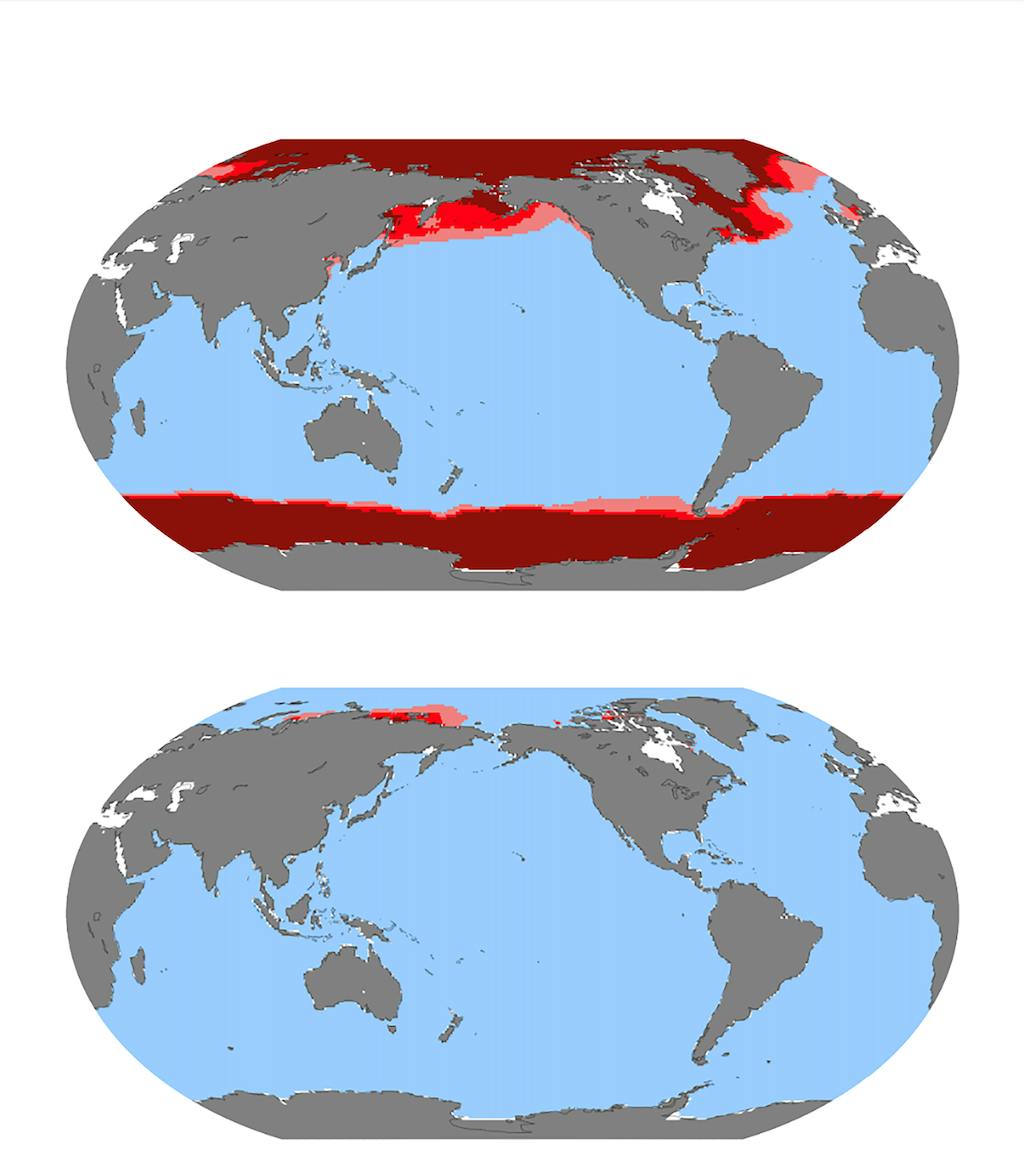
Ocean acidification in a world that is 3-4C (top) and 1.5°C (bottom) warmer at the end of the century. Source: International Cryosphere Climate Initiative (2023) / IPCC (2019).
“There is currently no practical way for humans to reverse ocean acidification,” the authors warn, adding that it will take some 30-70,000 years to bring acidification and its impacts back to pre-industrial levels.
As polar oceans become more acidic, they are also warming at an “unusually rapid” rate, the report warns. The authors note that since 1982, summer surface water temperatures in the Arctic have increased by around 2°C – mainly due to sea-ice loss that allows the sun’s rays to hit the water, and an inflow of warmer water from lower latitudes.
The map below shows the change in sea surface temperature over 1993-2021. Red indicates warming and blue indicates cooling, while the white at the highest polar latitudes is due to incomplete data for this period.
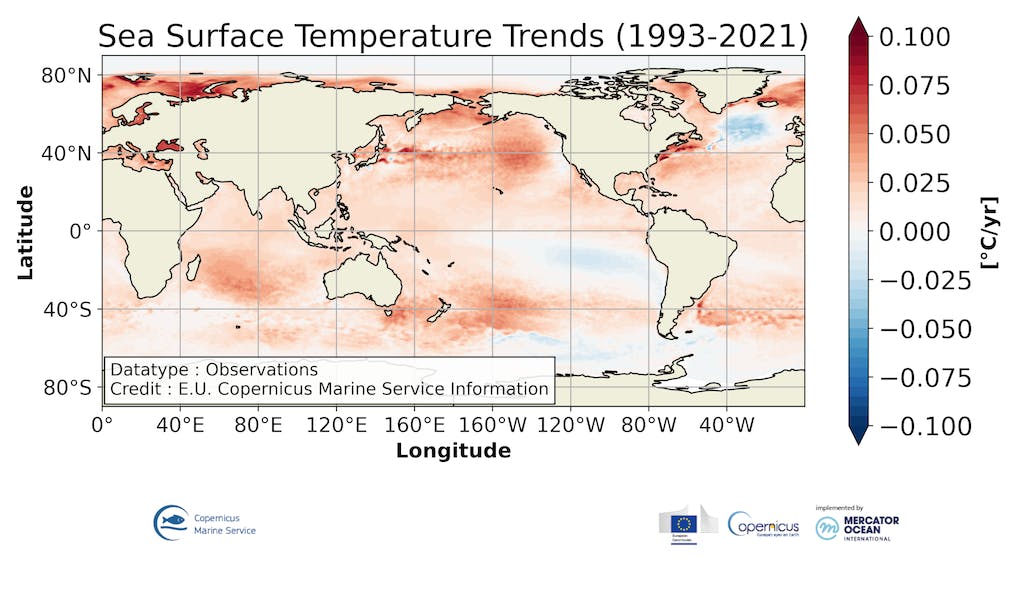
Change in sea surface temperature over 1993-2021, where shading indicates warming (red), cooling (blue) or insufficient data (white). Source: International Cryosphere Climate Initiative (2023) / EU Copernicus Marine Service Information
The map shows that near-polar waters such as the Barents Sea have warmed “extensively” over the past two decades. The colder patch in the south of Greenland is an exception which is partly due to cold freshwater being added as the Greenland ice sheet melts, it adds.
The authors add that increased run-off from glaciers, ice sheets and rivers is also affecting global ocean circulation, which could stall ocean currents such as the Atlantic Meridional Overturning Circulation (AMOC).
The report also warns that the dual impacts of ocean acidification and warming could have severe impacts for polar biodiversity, adding that “polar waters contain some of the world’s richest fisheries and most diverse marine ecosystems”.
Over the past decade, many polar species have experienced “lethal” temperatures which have caused mass-die offs, the report warns.
It also highlights the dangers of ocean acidification, including harm to key ocean-dwelling organisms which could “cascade” up the food chain. “Compound events combining marine heatwaves and extreme acidification have already caused population crashes even at today’s 1.2°C,” the authors say.
The report concludes:
“2°C will result in year-round, essentially permanent corrosive conditions in extensive regions of Earth’s polar and some near-polar seas; with widespread negative impacts on key fisheries and species.”
This story was published with permission from Carbon Brief.

